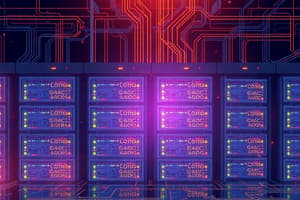Podcast
Questions and Answers
What is RAID and how does it work?
What is RAID and how does it work?
RAID (Redundant Array of Independent Disks) is a data storage virtualization technology that combines multiple physical disk drive components into one or more logical units for the purposes of data redundancy, performance improvement, or both. It works by distributing data across multiple disks, providing fault tolerance and improved data access speed.
What are the advantages and disadvantages of using RAID?
What are the advantages and disadvantages of using RAID?
The advantages of using RAID include improved data reliability, increased performance, and potentially lower costs compared to traditional backup solutions. However, the disadvantages include increased complexity, potential performance overhead, and the need for careful planning and management to realize the benefits of RAID.
What are the different RAID levels and their characteristics?
What are the different RAID levels and their characteristics?
There are several RAID levels, including RAID 0, RAID 1, RAID 5, RAID 6, and RAID 10. Each level has different characteristics such as data striping and mirroring for performance and redundancy, parity for fault tolerance, and various combinations of these techniques for different trade-offs between performance, redundancy, and storage efficiency.
Flashcards are hidden until you start studying



